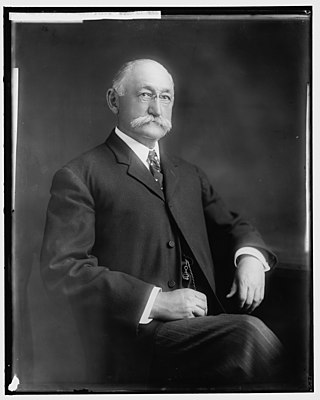
The du Pont family or Du Pont family is a prominent American family descended from Pierre Samuel du Pont de Nemours (1739–1817). It has been one of the richest families in the United States since the mid-19th century, when it founded its fortune in the gunpowder business. In the late 19th and early 20th centuries, it expanded its wealth through the chemical industry and the automotive industry, with substantial interests in the DuPont company, General Motors, and various other corporations.

Sherman Willard Tribbitt was an American merchant and politician from Odessa in New Castle County, Delaware. He was a World War II veteran and a member of the Democratic Party who served in the Delaware General Assembly, as the 17th lieutenant governor of Delaware, and as the 67th governor of Delaware.

James Asheton Bayard Jr. was an American lawyer and politician from Delaware. He was a member of the Democratic Party and served as U.S. Senator from Delaware.

The Philadelphia, Wilmington and Baltimore Railroad (PW&B) was an American railroad that operated independently from 1836 to 1881. Headquartered in Philadelphia, it was greatly enlarged in 1838 by the merger of four state-chartered railroads in three Mid-Atlantic states to create a single line between Philadelphia and Baltimore.

Preston Lea was an American businessman and politician from Wilmington, in New Castle County, Delaware. He was a member of the Republican Party who served as Governor of Delaware.

Caleb Prew Bennett was an American soldier and politician from Wilmington, in New Castle County, Delaware. He was a veteran of the American Revolutionary War and the War of 1812, and a member of the Democratic Party who served as Governor of Delaware.

Cornelius Parsons Comegys was an American farmer and politician from Dover Hundred, in Kent County, Delaware, near Little Creek. He was a veteran of the War of 1812, a member of the Federalist Party, and then later the Whig Party, who served in the Delaware General Assembly and as Governor of Delaware.

William Temple was an American merchant and politician from Smyrna, in Kent County, Delaware. He was a member of the Whig Party, and later the Democratic Party, who served in the Delaware General Assembly, as Governor of Delaware, and as U.S. Representative from Delaware. He is the youngest governor to serve in Delaware in all of its history.

William Tharp was an American politician from Milford in Kent County, Delaware. He was a member of the Democratic Party, who served in the Delaware General Assembly and as Governor of Delaware.

William Henry Harrison Ross was an American politician from Seaford, in Sussex County, Delaware, United States. He was a member of the Democratic Party who served as Governor of Delaware.

William Cannon was an American merchant and politician from Bridgeville, in Sussex County, Delaware. He was a member of the Democratic Party and later the Republican Party, who served in the Delaware General Assembly and as Governor of Delaware during much of the Civil War.

Willard Hall, was a Delaware attorney and politician from Wilmington in New Castle County. He was a member of the Democratic-Republican Party, who served in the Delaware Senate, as a United States representative from Delaware and as a United States district judge of the United States District Court for the District of Delaware. He served as the first President of the Delaware Historical Society, was President of the state Bible society, and was instrumental in the formation of the Wilmington Savings Fund Society as a community bank, serving as its president for more than 40 years.

William Lea was a member of a prominent flour milling family in Wilmington, Delaware, who was largely responsible for the development of the Brandywine Mills to their place of importance.
James Price (1776–1840) was a miller, businessman, banker, and railroad executive based in Wilmington, Delaware.
David C. Wilson was a 19th-century banker, businessman and railroad executive; and the third mayor of Wilmington, Delaware.
William Chandler was a 19th-century businessman based in Wilmington, Delaware, an active abolitionist, and an early railroad executive.
William Parvin Brobson (1786–1849) was a lawyer, Delaware state representative, newspaper editor, and railroad executive.
Henry Whitely was a businessman, railroad executive, and Federalist politician from the U.S. state of Delaware.
The following is a timeline of the history of the city of Wilmington, Delaware, USA.

Wilmington and Brandywine Cemetery is a rural cemetery at 701 Delaware Avenue in Wilmington, Delaware. Founded in 1843, it contains over 21,000 burials on about 25 acres.